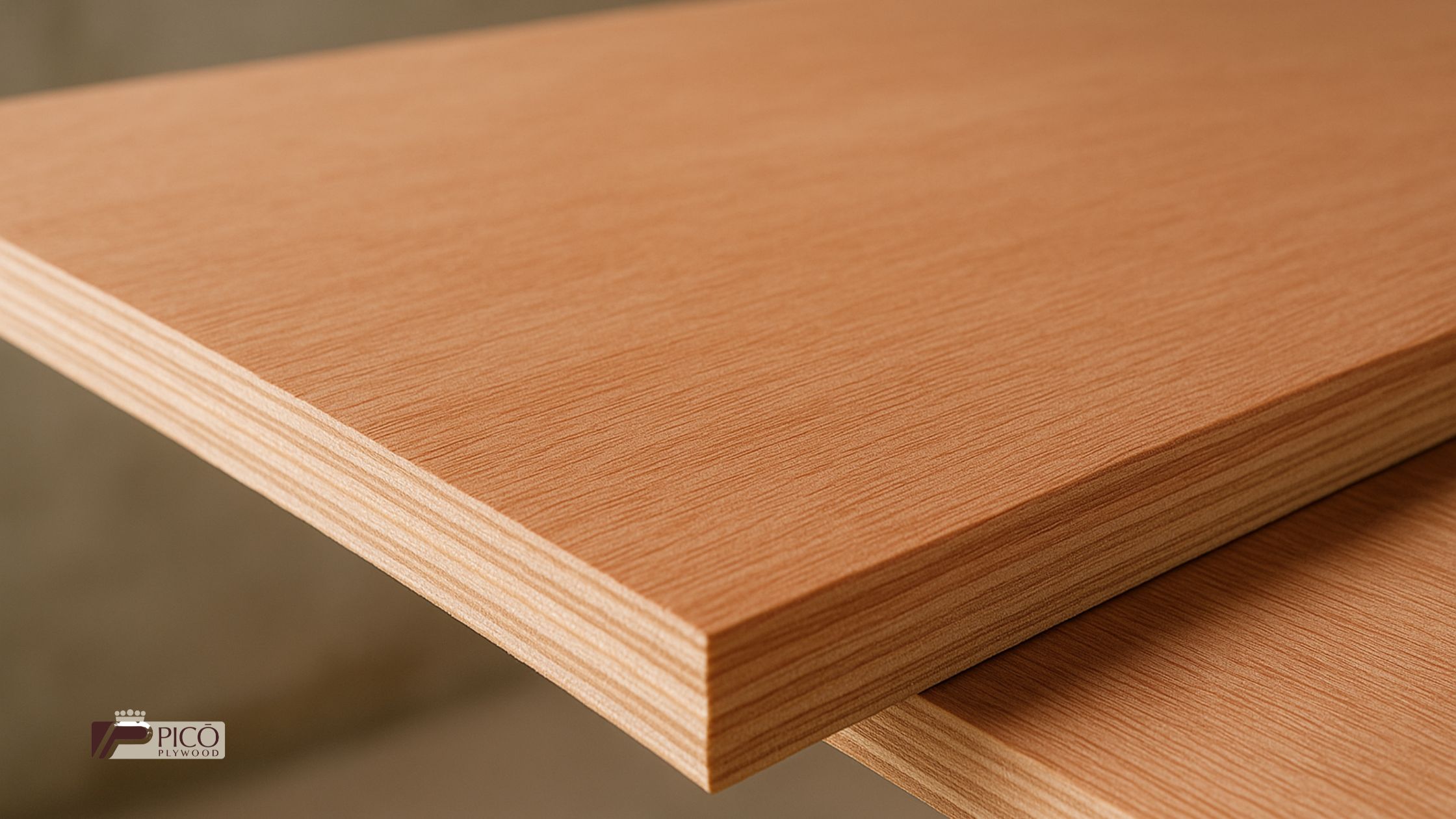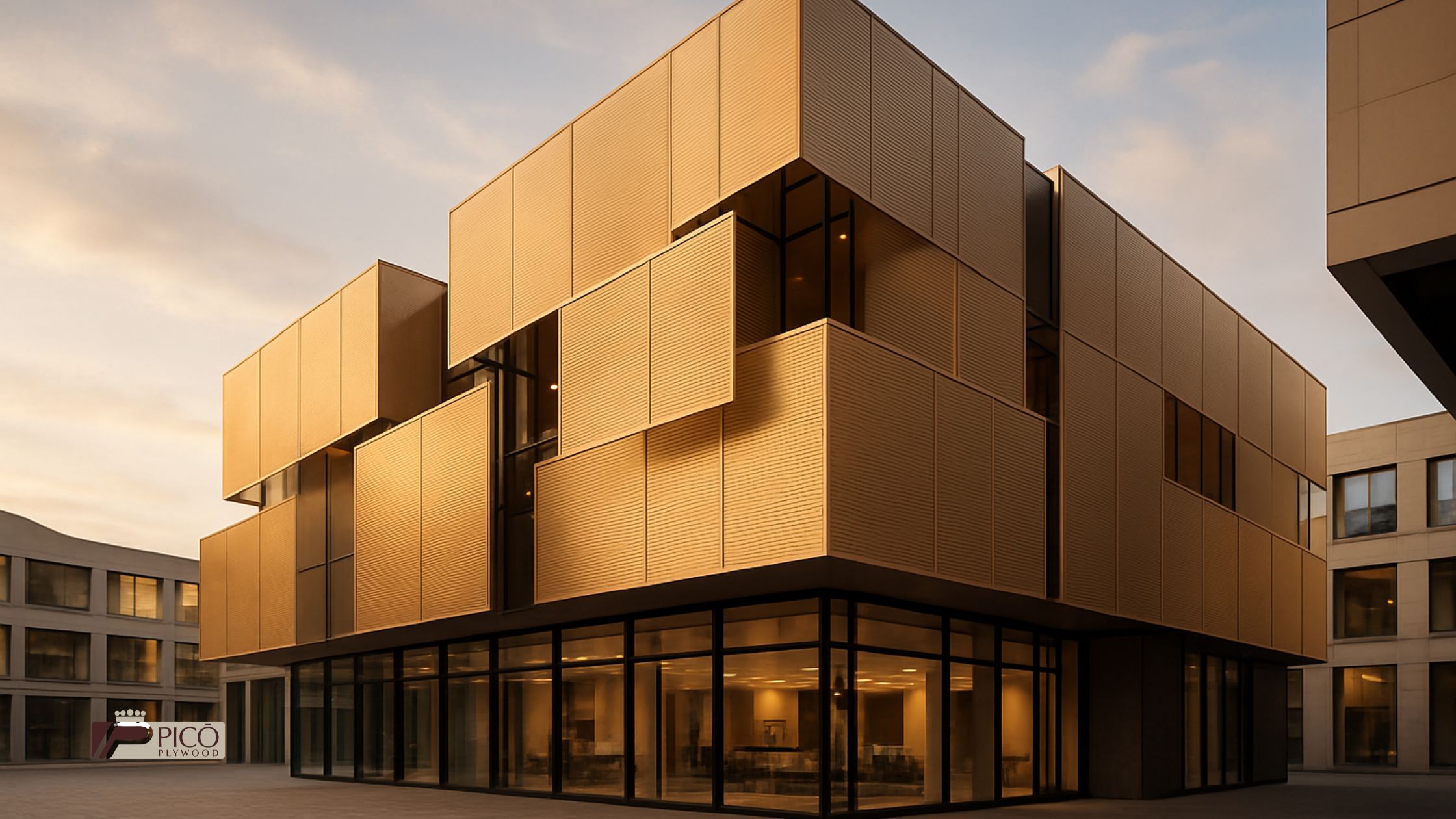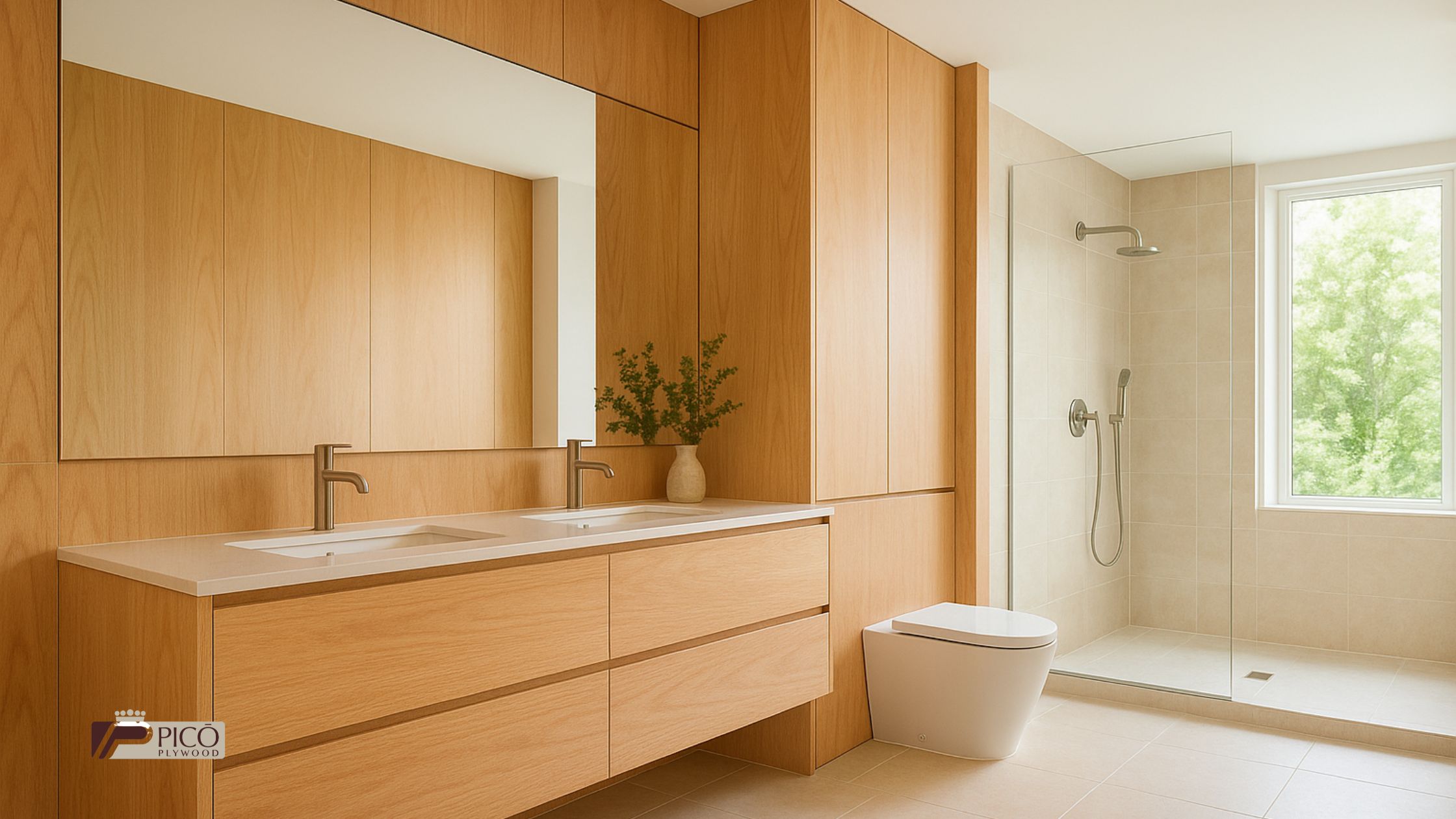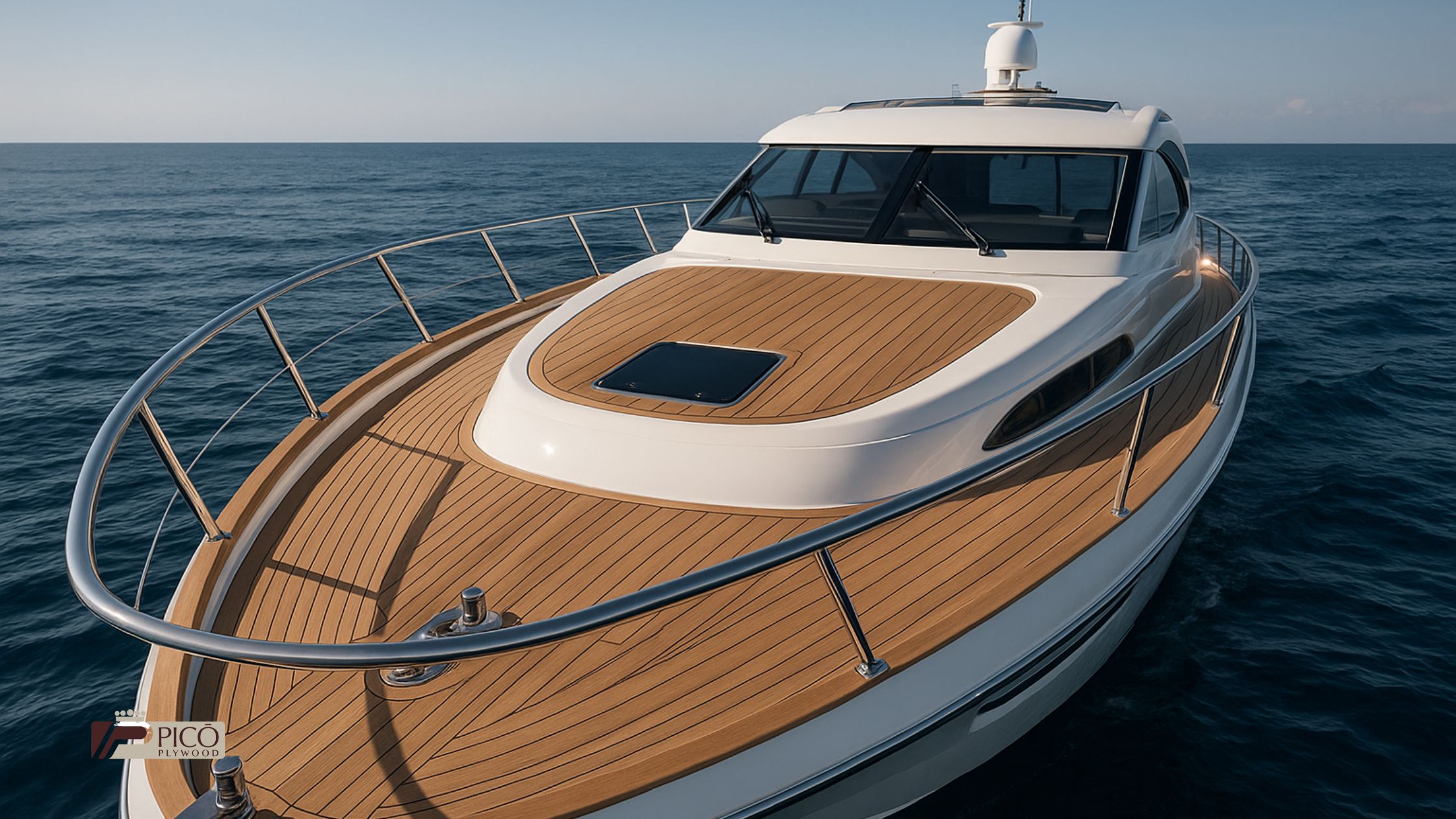pico Plywood Contact
Contact Information
To learn more about our Plywood Products or discuss your project requirements, please reach out to us through the following channels.
Plywoood

Table of Contents for the Article
Okoume plywood has become one of the most versatile and valued materials in industries as diverse as shipbuilding, cabinetry, and interior design. Sourced from the Aucoumea klaineana tree, native to West Africa, okoume wood stands out for its characteristic light pink tone, exceptional lightness, and dimensional stability. These qualities make okoume plywood especially sought after by both professional carpenters and DIY enthusiasts looking for a noble, durable, and easy-to-work material.
Throughout this article, you will discover the uses of okoume plywood, its main advantages, and how to choose the most suitable panel for your project.
Okoume plywood is a multilayer panel made from thin sheets of okoume wood (Aucoumea klaineana), a fast-growing tree found mainly in Gabon, Equatorial Guinea, and other West African countries. This tree can reach heights exceeding 30 meters and produces wood ranging in color from pinkish to light brown, with a uniform grain that is smooth to the touch.
The characteristics of okoume include a moderate density of approximately 430 kg/m³, making it a lightweight yet strong wood ideal for applications where weight is a critical factor. Its uniform cellular structure allows precise machining without excessive splintering, facilitating clean cuts, milling, and drilling.
Marine okoume plywood, in particular, is manufactured with phenolic or moisture-resistant resin adhesives, guaranteeing durability even in demanding environments.
The combination of lightness, workability, and strength has positioned okoume plywood as a premium choice in multiple industries.
One of the most appreciated properties of okoume plywood is its low specific weight. With approximately 30% less weight than other plywoods such as birch or oak, okoume panels greatly facilitate transport, installation, and overhead work. This feature is especially relevant in shipbuilding and in caravan or motorhome projects, where every kilogram counts for efficiency and vehicle performance.
Okoume plywood exhibits excellent stability against temperature and humidity variations. The cross-laminated structure of its veneers minimizes contraction and expansion, reducing the risk of deformation, warping, or cracking. This makes it a reliable material for applications requiring dimensional precision over time.
When manufactured as marine okoume plywood with phenolic water-resistant adhesives (WBP – Water and Boil Proof classification), this plywood can withstand prolonged exposure to humid environments without losing its mechanical properties. Although okoume wood is not naturally rot-resistant, proper treatment with varnishes, sealers, or marine oils can significantly extend its lifespan even in nautical applications.
The fine, homogeneous grain of okoume provides an exceptionally smooth surface that accepts all types of finishes: varnishes, lacquers, stains, decorative veneers, or laminates. This makes interior okoume plywood especially valued in high-end cabinetry and design projects where final aesthetics are essential. The wood’s ability to absorb finishes evenly ensures professional results without complex preparation.
Many suppliers, including Pico Plywood, offer FSC-certified okoume plywood (Forest Stewardship Council), guaranteeing that the wood comes from responsibly and sustainably managed forests. This certification is increasingly important for projects seeking environmental credentials or needing to comply with sustainable building regulations. The advantages of okoume therefore include not only technical but also environmental aspects.

The most emblematic use of okoume plywood is undoubtedly in boatbuilding. Its combination of lightness, strength, and stability makes it the preferred material for building sailboat hulls, yachts, kayaks, and light boats.
Marine okoume plywood is used both in primary structures (frames, bulkheads, hull bottoms) and in decks and cladding. Its ability to bend under hot or cold conditions allows for creating complex hydrodynamic shapes without specialized equipment. Additionally, its low weight improves buoyancy and vessel performance.
Okoume applications in joinery are extensive—from living room and bedroom furniture to built-in wardrobes, shelving, and kitchen units. The warm pinkish tone of okoume wood adds visual warmth to any interior space, while its smooth surface facilitates natural finishes that enhance its characteristic grain.
Interior okoume panels are particularly valued in contemporary design projects that seek noble yet lightweight materials.
In interior architecture, okoume plywood is frequently used as wall, ceiling, and partition cladding. Its natural aesthetics and ability to accept various treatments (staining, varnishing, lacquering) make it ideal for creating sophisticated environments. Okoume panels are also used in commercial premises, offices, and public spaces where durability and visual appeal are both important.
The caravan, motorhome, and food truck industries frequently use okoume plywood for its excellent strength-to-weight ratio. Walls, floors, and ceilings made with this plywood reduce the vehicle’s total weight, improving fuel consumption and maneuverability. It is also used in horse boxes, specialized trailers, and portable structures where lightness is essential.
DIY enthusiasts particularly value the uses of okoume plywood in custom projects—from speaker boxes (where the wood’s controlled resonance improves sound quality) to architectural models, handcrafted musical instruments, and design prototypes. Its ease of cutting and machining makes it accessible even to amateur carpenters with basic tools.

Comparing okoume vs. birch is common in carpentry and joinery. Birch offers a lighter and harder surface with greater impact resistance but is significantly heavier (around 680 kg/m³ versus 430 kg/m³ for okoume).
Aesthetically, birch has a more pronounced grain and a yellowish tone, while okoume stands out for its smooth appearance and pink color. For projects where weight is critical (such as boats or vehicles), okoume is clearly superior; for applications requiring maximum surface hardness, birch may be more suitable.
Pine plywood is generally more economical than okoume but shows greater density variations due to differences between early and late wood, resulting in a less uniform surface.
The okoume vs. pine comparison favors the former in terms of dimensional stability and surface quality, especially when smooth, varnished, or lacquered finishes are desired. Pine, however, may be preferable for structural applications with lower aesthetic requirements where cost is the priority.
Phenolic plywood (particularly birch or poplar phenolic) offers superior resistance to moisture and abrasion thanks to its phenolic resin coating. Comparing okoume vs. phenolic shows that the latter is more suitable for formwork, industrial vehicle floors, and applications requiring high surface wear resistance. However, phenolic plywood is heavier, less aesthetic, and more difficult to machine for fine finishes.
For nautical, joinery, and interior design applications, okoume maintains decisive advantages in weight, workability, and appearance.
The choice between different plywood types should be based on each project’s specific priorities: weight, strength, aesthetics, cost, and ease of working.

The market offers several types of quality okoume plywood. Raw okoume has both faces unsanded, ideal for projects where additional coverings will be applied. Sanded okoume on one or both sides (BB/BB, BB/CC) is suitable for visible joinery work.
Marine okoume plywood incorporates WBP phenolic adhesives and is specifically designed for humid environments. Some suppliers also offer okoume with one melamine or phenolic-coated face for specific applications.
The most common thicknesses of okoume plywood range from 4 mm to 25 mm, though thicker panels can be made to order.
Standard sizes are 244 x 122 cm (8′ x 4′) and 250 x 125 cm, with special measurements also available.
To choose the right okoume plywood, consider structural loads: thicknesses of 4–6 mm are sufficient for light cladding, while structural marine applications typically require 9–15 mm.
When selecting your panel, verify that it carries FSC or PEFC certified okoume, guaranteeing responsible forestry practices.
Also, check adhesive classification: E1 or E0 for low formaldehyde emissions in habitable interiors, and WBP (Water and Boil Proof) for marine or exterior applications.
Standard EN 636-2 or EN 636-3 certifies the panel’s suitability for humid environments.
For shipbuilding, prioritize panels with marine certification, WBP phenolic adhesive, and at least BB/BB grading on both sides.
In interior joinery, a BB/CC okoume (one higher-quality face) may suffice if only one face will be visible.
For design projects where both sides matter, invest in BB/BB quality.
If the budget is limited and the final finish will include opaque paint or laminate, lower grades like BB/CP or CC/CC can be chosen, reducing costs without compromising structural integrity.
Maintaining okoume plywood is essential to ensure its durability, especially in applications exposed to moisture or weathering.
In marine environments, it is recommended to apply at least three coats of high-quality marine varnish for okoume, lightly sanding between coats.
Penetrating marine oils (such as tung oil or specific teak oils) offer a natural alternative requiring periodic reapplication but providing effective protection against moisture.
The durability of okoume wood can extend for decades with proper care.
In well-maintained boats, okoume panels have been shown to exceed 30–40 years of service life.
The key is to protect the material from direct standing water and to periodically inspect and restore protective finishes, especially at joints and edges where moisture penetration is most likely.
When looking to buy okoume plywood, it is essential to choose a specialized okoume supplier that guarantees traceability, quality, and certifications.
Pico Plywood has established itself as a benchmark in the supply of premium plywood panels, offering a wide range of okoume plywood in various thicknesses, grades, and finishes.
As a specialized supplier, Pico Plywood provides personalized technical advice to help you select the most suitable panel according to your project specifications.
The company works directly with certified sawmills, ensuring that each okoume board meets international quality and sustainability standards. Additionally, it offers custom cutting services, facilitating material optimization and reducing waste.
The advantage of working with a specialized okoume supplier like Pico Plywood also includes access to permanent stock, competitive delivery times, and after-sales support.
For professional or personal projects requiring maximum quality assurance, choosing an experienced and reputable supplier makes the difference between success and execution problems.

Marine okoume plywood manufactured with WBP phenolic adhesives is highly water-resistant and can withstand temporary immersion and continuous moisture exposure.
However, the wood itself is not waterproof and requires proper sealing with varnishes, oils, or marine paints to protect it from water absorption and degradation.
Standard okoume (with E1 or MR-type adhesives) should not be used in constantly humid environments without additional protection.
Okoume plywood can be used outdoors as long as it receives proper protection through UV- and moisture-resistant finishes.
For permanent outdoor applications, it is essential to use marine-grade panels with WBP adhesive and apply multilayer protection systems including primer, varnish, or high-durability exterior paint.
Surfaces exposed directly to rain and sun require regular maintenance to preserve material integrity.
The main difference is that “okoume” refers to the wood species used in the plywood veneers, while “phenolic” describes the type of adhesive (phenolic resin) and often a phenolic resin coating on the outer faces of the panel.
A panel can be “phenolic okoume” if made with okoume veneers and phenolic adhesive.
Typical phenolic boards usually use birch or poplar and have resin-hardened surfaces offering greater abrasion resistance but less fine finishing capability than pure okoume.
Maintenance depends on the application.
For interiors, periodic cleaning and occasional finish inspection are sufficient.
For marine or outdoor applications, annual inspection, light sanding of worn areas, and reapplication of varnish or protective oil are recommended.
Joints, edges, and fastening points require special attention, as they are the most vulnerable areas to moisture penetration.
Regular preventive maintenance can multiply the panel’s lifespan.
Certified okoume is available through specialized quality plywood suppliers such as Pico Plywood, which guarantees FSC or PEFC certification and full traceability of its products.
It is advisable to request certification documents before purchase and verify that the supplier can provide complete technical datasheets, including adhesive classification, compliance standards, and dimensional specifications.
Specialized distributors also offer quality guarantees and technical support—advantages not always available in general retail outlets.
pico Plywood Contact
Contact Information
To learn more about our Plywood Products or discuss your project requirements, please reach out to us through the following channels.
Plywood supplier, Plywood boards, Veneered plywood panels, Special Plywood
Contact information

Esta web utiliza cookies para que podamos ofrecerte la mejor experiencia de usuario posible. La información de las cookies se almacena en tu navegador y realiza funciones tales como reconocerte cuando vuelves a nuestra web o ayudar a nuestro equipo a comprender qué secciones de la web encuentras más interesantes y útiles.
Strictly necessary cookies must always be enabled so that we can save your cookie setting preferences.
If you deactivate this cookie we will not be able to save your preferences. This means that each time you visit this website you will have to activate or deactivate cookies again.
Esta web utiliza Google Analytics para recopilar información anónima tal como el número de visitantes del sitio, o las páginas más populares.
Dejar esta cookie activa nos permite mejorar nuestra web.
Please enable strictly necessary cookies first so we can save your preferences!